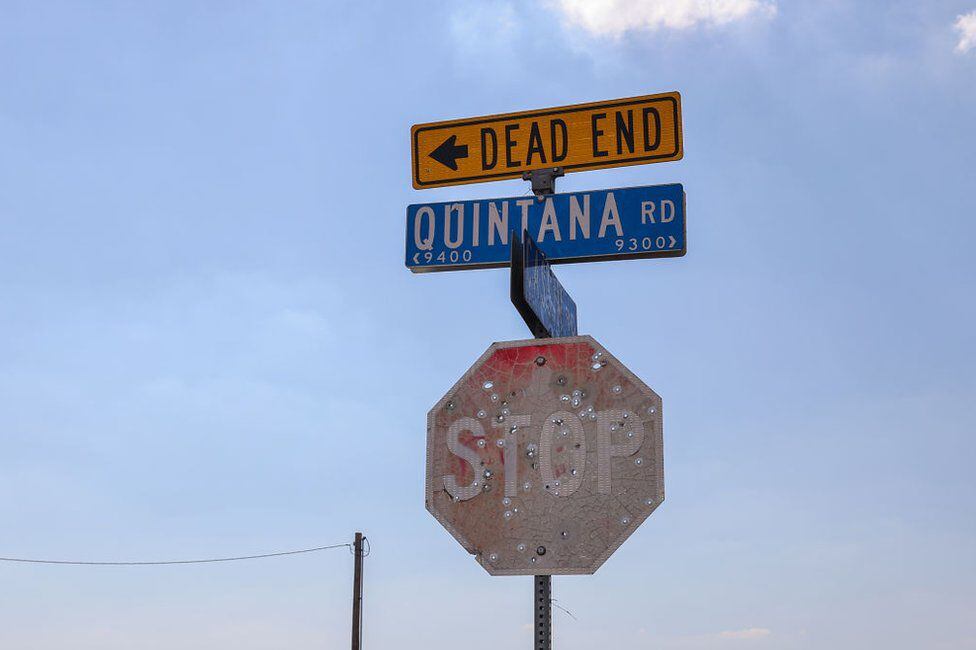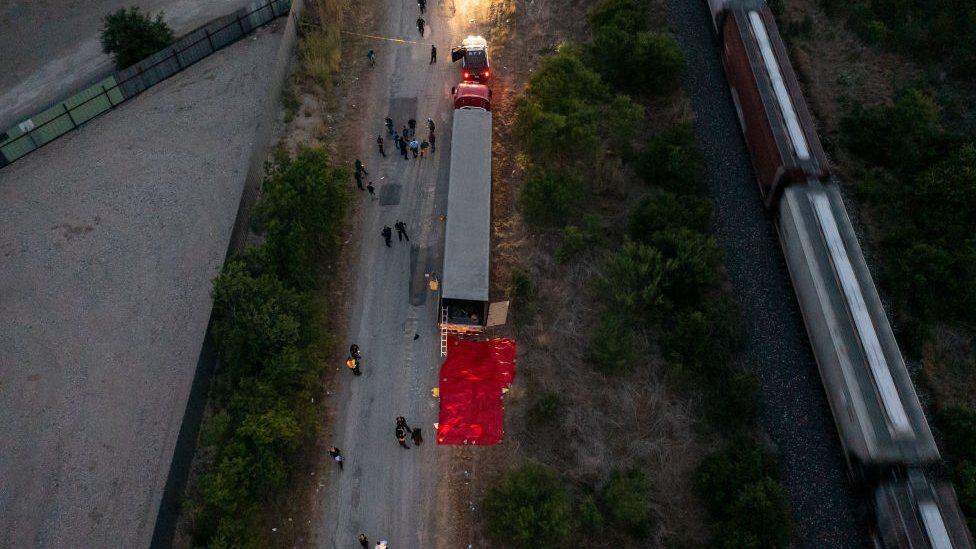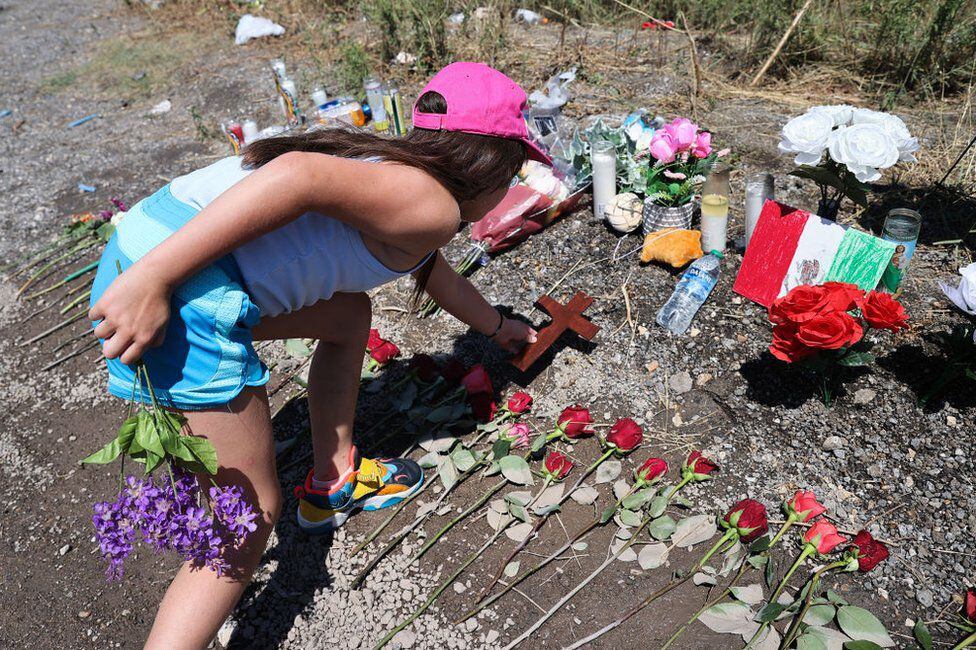“Look at me: do I look like an American to you? Do you know how many times I was called a bean-eater at school? How did I see my mother slave to get some papers? And they ask me why I am so affected.”
At the vigil to remember the migrants found dead Monday in an abandoned truck in southwest San Antonio, Texas, and those who later died in city hospitals —40 men and 13 women, 53 in total—, Wanda Pérez Torrescano cannot hide her anger.
Look: Who is Ketanji Brown Jackson, the first black woman to reach the US Supreme Court?
“It is that we are honoring people whose families still do not know that they have died, who are still waiting for that call that says: ‘Mommy, I arrived at the border, I’m fine,’” says energetically, microphone in hand, before the dozens of people gathered this Wednesday in the central Travis Park.
And I know because I’ve been on the other end of the phone.either”.
Born in Mexico City and raised in San Antonio, she is not the only one who feels the greatest immigration tragedy in living memory on US soil.
In a similar solemn act, the day before, the Honduran Jessica recalled how she herself was in the shoes of the migrants who now left without water or air conditioning in a trailer with an outside temperature of 40 degrees.
“I came here when I was 14 years old, also in a trailer (18 wheelers) and I lost consciousness from the heat”he said excitedly during the vigil. Asked later if she wanted to tell her story to BBC Mundo, she replied: “It keeps triggering a lot of emotions in me. I still have a lot to process and I don’t feel ready to give details.”
While that was happening in the historic center of San Antonio, others honored the dead in the same place where the truck was found: a dusty road between a lumberyard and a train track, in a landscape dotted with auto parts sales. .
The first two crosses —very colorful— were placed there on Tuesday by Angelita Olvera, the daughter of a Potosino, and Debra Ponce, who warns that “you have to keep an eye on Texas, because civil rights as we know them are going to change.” .
Since then, that soulless corner has been filled with flowers and candles, like those placed by the Honduran Gabriela and her two daughters, and with posters calling for respect and solidarity. The artist Roberto Márquez, who himself crossed from Tijuana to the US 40 years ago, paints a mural that gives a certain air to the Guernica of Picasso.
And it is that migration is very present in this city located just 250 kilometers north of the border with Mexico.

Key city in migratory transit
Experts and organizations consulted by BBC Mundo for this article and officials who asked not to publish their names describe the city of 2.5 million inhabitants as a “transit center”a strategic place where several migrant routes converge, surrounded by highways that cross the country from north to south and from east to west.
Edward Reyna, a security employee of the lumber company located a few meters from where the truck was left, he has already lost count of the times he has seen Mexicans and Central Americans, among people of other nationalities, jump from the train what’s going on right there.
“I already knew that sooner or later someone would get hurt,” he told the BBC. “The cartels that bring them don’t care about anything.”
The ones he meets during his shifts are the ones who have not been intercepted by immigration authorities.
In May, Customs and Border Protection (CBP) recorded nearly 240,000 “encounters”a third more than the same month the previous year.
This despite the fact that the governor of Texas, the Republican Greg Abbott, launched Operation Lone Star in March 2021 and that May issued a “disaster declaration” that allows him to deploy the National Guard on the border and now covers 53 counties. All this to try to stop the increase in border crossings, which he attributes to the immigration policies of President Joe Biden.

But migrants continue to arrive and transit through the state, some hidden in trucks, a modus operandi very specific —although not exclusive— to this border area, Guadalupe Correa-Cabrera tells BBC Mundo.
A professor at the George Mason University of Faixfax, Correra-Cabrera has been studying migratory routes for years, including the one that transits from Nuevo Laredo, in Mexico, to Laredo, in the United States, through the most important land customs for merchandise in the hemisphere.
That itself makes it impossible to check all the cargo that crosses that bridge every day, explains the expert. “There are no official figures, but it is estimated that less than 5% is verified.”
Although he clarifies that the traffic of migrants in trailers does not necessarily start in Mexico. Based on testimonies compiled by herself, she says that in some cases the traffickers pick them up in trucks already on the Texas side.
This is what the Department of Homeland Security investigators leading the investigation believe happened in the case of the abandoned truck on Monday, Congressman Henry Cuellar told the AP agency.

Those who leave, those who remain
Regardless of the way they come, by whatever means of transport, a large part of the migrants who arrive in San Antonio are usually passing through, the immigration authorities confirm to BBC Mundo. They usually spend the night in a space provided by different organizations that support them or at the airport or bus station.
Although there are those who stay, like Lemi, a Cuban who arrived four years ago and works as a taxi driver in the city. His plan is, sometime next year, to go with his wife and his 11-month-old son to Florida.
Or his compatriot Jose, who after suffering hardships in the Darién jungle, in Ecuador and other countries through which he traveled, crossed into the US and turned himself in to Immigration on May 25, the day after the shooting that left 21 dead. in a primary school in Uvalde —a town a little over an hour and a half by road from the border—.
As soon as he was released, he got on a Greyhound company bus —in which he told me his story— towards the San Antonio station.
Also staying in the city, at least for now, was Carlos, a 34-year-old migrant from Venezuela who, after crossing several countries, when he reached the southern border of Mexico decided that the best way to go north was by motorcycle.
“In Monclova (in the northern state of Coahuila, which borders the US) I had an accident, they operated on me and now I have a plate here,” he says, pointing to his left thigh.
While he regains strength in his leg to be able to work, he waits in the Posada Guadalupe, managed by Father Phil Ley.
Originally from Indiana, he set up the first migrant shelter in San Antonio 16 years ago. “I started receiving people sent from hospitals, because they were injured or diabetic and needed dialysis. Until a lawyer (specialized in immigration) asked me for permission to house a client who had just turned 18 and could no longer be in the ICE Detention Center for minors,” he recalls for BBC Mundo.
“That’s how the word spread among other lawyers,” he says, and his ended up being a shelter especially for young migrants. This Wednesday she had 21. “Tomorrow another one arrives, and on Saturday one more,” she says.
Asked about what happened with the abandoned truck with the migrants inside, he says that it is a disgrace that “saddens and angers him at the same time.”
These are the same feelings that Wanda Pérez shared with those attending the vigil this Wednesday, those who feel the tragedy as their own, those expressed by all those who spoke to BBC Mundo for this report and described the event as a “mass murder”.
“Tragedies like this make the problem visible, while making us think about how sophisticated these networks are, how many people and money they move, and how little we know about them”closes the researcher Correra-Cabrera.
Source: Elcomercio
I, Ronald Payne, am a journalist and author who dedicated his life to telling the stories that need to be said. I have over 7 years of experience as a reporter and editor, covering everything from politics to business to crime.

:quality(75)/cloudfront-us-east-1.images.arcpublishing.com/elcomercio/GE4TCMJNGA3C2MZQKQYDAORRHE.jpg)



:quality(75)/cloudfront-us-east-1.images.arcpublishing.com/elcomercio/2RSB7ULP6VARDIE2VSEV5IG2EY.jpg)

